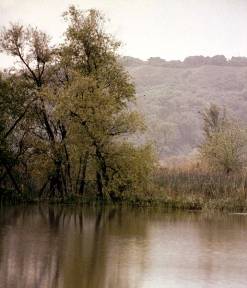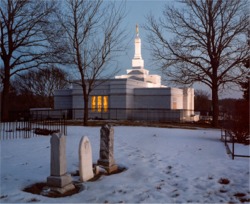Winter Quarters
Following persecution by mobs and their neighbors, including the murder of Joseph Smith, the prophet, the members of the The Church of Jesus Christ of Latter-day Saints began leaving Nauvoo, Illinois, on February 4, 1846. They planned to leave in the spring, but persecution was so fierce that they began to leave early. They crossed the frozen Mississippi and traveled awhile before setting up camp.
On March 1, a large group of Latter-day Saints began leaving the camp. Brigham Young, president of the Quorum of the Twelve Apostles—which lead the Church after Joseph Smith's death, had hoped that he could get a group of Mormon Pioneers all the way to the Salt Lake Valley that year, but travel across Iowa was slow. There were heavy rains, and the ground thawed, causing it to be muddy and hard to drive through with oxen and heavy wagons. Because traveling was taking so long, food supplies began to run low, and because of the weather, many were sick.
That first group finally reached the Missouri River on June 14th. The trek across Iowa took 131 days. The first company traveled all the way to Salt Lake in just 111 days and the distance was twice what the Saints had just covered in crossing Iowa. It was too late in the year to continue on to Salt Lake as Brigham Young had planned, and so a settlement was built where the Saints could spend the winter. This decision was also made because the U.S. Government (the same government that was allowing them to be driven from their homes) had made an order that 500 of the men join the army to help fight in the Mexican war. This group became known as the Mormon Battalion[1]. The settlement had to be built quickly, and roads were laid out, followed by cabins. Until cabins were finished, many lived in tents, dugouts, or caves.
Living conditions were still poor, even in the cabins, because there were few furnishings and there had not been enough time to build all the cabins that were needed before winter came. Most cabins housed two or more families. In December of 1846, there were more than 5,000 people in the settlement that the Saints called Winter Quarters. There were only 700 log cabins and 83 sod houses.
Back in Nauvoo, many of the Saints had stayed behind because they did not have the money to get provisions for the journey or because they were sick. The mobs grew impatient with those who were still there and attacked the city on September 10, 1846. The Battle of Nauvoo, as it was called, was really just the mobbing of the last few remaining Latter-day Saints, who were out-gunned and out-manned by the mobs. The attack continued for several days until an agreement was reached. Every Latter-day Saint was forced to leave, except five men and their families who remained behind to sell property. Between five and six hundred Saints crossed the Mississippi and camped in Iowa. None of them had the proper provisions and many were sick. The Latter-day Saints in Winter Quarters heard of their plight. Many crossed Iowa again to help them and others began gathering money to send to them.
The living conditions caused many problems.
- “Much sickness was caused by malaria-carrying mosquitoes from the river marshes and by the lack of fresh fruits and vegetables for good nutrition. More than six hundred people died and were buried in Winter Quarters that fall and winter. Most of the people in Winter Quarters became sick, and the few who did not become sick spent all their time taking care of others. Vilate Kimball, wife of Apostle Heber C. Kimball, went throughout the settlement bringing food and taking care of the sick. She was so busy helping others that she seldom took time to eat or take care of herself. Many people were healed through fasting and prayer and the willingness of others to serve and take care of them” ("The Saints Build Winter Quarters,” Primary 5: Doctrine and Covenants: Church History, [1997], 222).
It was here that Brigham Young was sustained as the second president of the Church of Jesus Christ in December of 1847 at a conference held in the Kanesville Tabernacle[2].
In 2001, The Church of Jesus Christ of Latter-day Saints dedicated the Winter Quarters Nebraska Temple. The area also has a Mormon Trail Center and a memorial to those who gave their lives for the Church. The National Park Service also maintains a site there as part of the Mormon Pioneer Trail.

